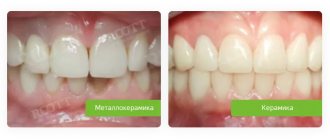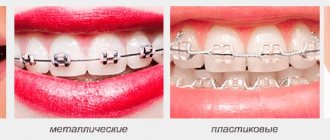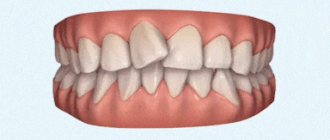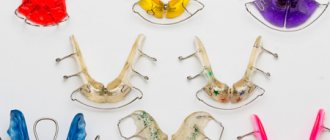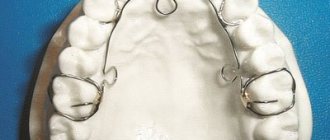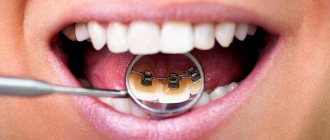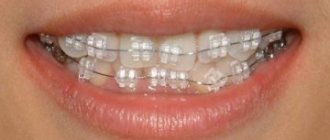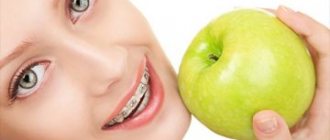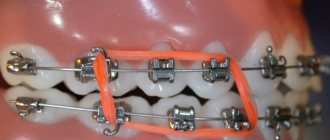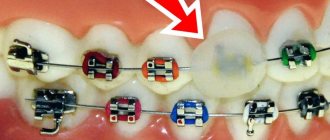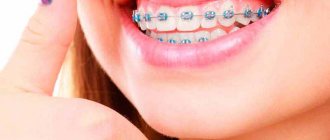One of the characteristics of teeth is mobility, and this quality allows orthodontists to change their position, correcting the bite. Therefore, the principle of operation of all orthodontic devices is similar - they set the direction for a gradual change in the position of the teeth.
For correction, different orthodontic systems are used - plates, aligners and braces. In this article we will tell you how they differ from each other.
Let's look at tools that help people feel free to smile
Plates for teeth
A plate is a removable orthodontic appliance that is used to correct malocclusion in children aged 6 to 13 years. The main purpose of this device is to expand the dentition.
Expansion of the dentition occurs due to the gradual unwinding of the screw in the center of the structure
The plate has a plastic base that follows the shape of the palate and the inner surface of the teeth. One or more screws are placed in the center, due to which the correction will occur. Plates solve the most common problem of crowding of teeth due to lack of space in the child's jaw.
Correction needs to be done once every month and a half. The orthodontist will gradually unscrew the screw, each turn expanding the plate by 0.25 mm. As a rule, pressure on the jaw is felt in the first 5–15 minutes after correction.
The plate may also contain elements for correcting individual teeth, for example, to correct tilt or rotation.
The duration of treatment with plates is on average 1.5–2 years. They are worn, depending on the doctor’s recommendations, from 18 to 24 hours a day.
The plate is removed when eating and brushing teeth
Plates are individual devices that are made for each patient. Depending on the clinical cases, single-jaw or double-jaw systems are used: from the name it is clear that the former correct one jaw, the latter – both at once.
Plates can also be made with artificial teeth - they are necessary if, for some reason, the child has lost milk teeth early. Early tooth loss can cause malocclusion, for example, when neighboring teeth begin to take the place of the missing one, and over time there is no place for the molar to erupt.
Cleaning the Removable Retainer
- Use a brush
It is recommended to clean the device twice a day, while brushing your teeth:
- remove the plate;
- rinse under running water;
- squeeze a small amount of paste onto the brush, carefully clean the plate;
- rinse the structure, then place it in the mouth or place it in a container.
- Use a cleanser
From time to time you need to soak the device in a special cleaning composition.
For these purposes, the doctor may prescribe:
- mouthwash or plate cleaning tablets;
- baking soda solution (2 teaspoons of powder in a small container of cool water).
Reference! It is not recommended to use vinegar, as it has an aggressive effect on metal and plastic structural elements.
- Avoid drying out
The retainer is designed to constantly remain in the mouth with moist microflora. If you remove the device, place it in liquid - this will avoid drying out and destruction:
- take water at room temperature into a small container and place the plate there (distilled water that does not contain harmful impurities and has a normal acid-base balance is suitable for these purposes).
Aligners
These are transparent removable mouth guards made of hypoallergenic material, which are used to correct bite in children over 12 years of age and adults. Age restrictions are due to the fact that aligners can be prescribed when jaw growth has stopped, that is, after 12–14 years.
Aligners are clear aligners that are less noticeable when worn than a plate or braces.
Aligners are prescribed when there are gaps between teeth that spoil the aesthetic appearance. They also help solve the problem of crowded teeth, change the position or inclination of each tooth, and correct crossbites or open bites. In severe cases or in very difficult cases, this orthodontic system will not be sufficient and braces may be required.
Like plates, aligners are individual for each client. They are created using a 3D model, taking into account how the position of the teeth will change step by step. That is, if the doctor adjusts the plate according to the schedule, then the aligners will simply need to be changed every 2-4 weeks on your own. A set can on average include from 8 to 40 sets, depending on the complexity of the case. As a rule, the first results become noticeable after 3-4 months of wearing.
The client receives a full set of aligners for the entire correction period
After treatment, a retention period begins, during which you need to consolidate the result with the help of retainers. If it is missed, the teeth may return to the position they were before treatment.
Aligners should be worn for 20–22 hours a day, only being removed when eating or brushing your teeth. The advantage of this device is that it does not impose dietary restrictions: for example, while wearing braces you cannot eat solid foods such as nuts, crackers, apples.
Russian Star Smile aligners have made the technology of orthodontic treatment with aligners accessible, since the final cost does not include transportation costs from abroad. In addition, their production time is reduced. The treatment process takes on average from 3 to 15 months.
Caring for the removable plate
- Follow your doctor's recommendations
Some patients are advised to use the device continuously. To minimize the likelihood of damage to it, it is important to follow the orthodontist's instructions and ask any questions you have.
Wearing a plate is necessary to consolidate the result of correction of the bite and dentition. The duration of use is determined by the doctor taking into account the clinical picture. Typically, plates are worn for the same amount of time as braces.
Continuous wearing of the structure is indicated for some time, later use at night is allowed.
- Remove the plate before eating
Residues of food can get stuck between the elements of the device, so when eating it is recommended to remove it and put it in a special container.
- Wear a mouthguard when playing sports
Under active loads there is a possibility of damage to the plate, therefore:
- in order to continue protecting your teeth, remove the retainer and put on an orthodontic mouthguard;
- It is better to avoid contract sports during the period of orthopedic treatment, since the bones are in a weakened state and are subject to various damages;
- When removing the retainer, it should be placed exclusively in the container. Therefore, you should always take it with you.
Braces
This is a non-removable orthodontic system, which is especially relevant for severe bite defects. A lock is attached to each tooth on the outside or inside, depending on the type of braces, and they are connected to each other with arches. This puts constant pressure on the teeth, which forces them to change position, and the bite is corrected. Only a doctor can install, adjust or remove braces.
Braces consist of clasps and arches - the first are fixed on the teeth, the second connect them together
The brace system is a standard solution, so the doctor must conduct inspections quite often and manually adjust the direction of the arc. Mini-screws, elastic bands and silicone chains are often additionally used, which in themselves cause discomfort to patients. On average, treatment with braces takes from one to three years. After this, a consolidation period is required, when retention mouth guards are put on at night or permanent retainers are used - metal arches installed on the inner surface of the teeth.
While wearing braces, you need to visit an orthodontist for adjustments. On average, once every 3-4 weeks, the doctor changes the arches, which put pressure on the teeth.
The systems differ from each other in the method of fastening and material of manufacture. Thus, braces can be attached to the outside or inside of the teeth. In addition, they come in metal, ceramic or sapphire. In the first case, the locks are made of metal and are noticeable when worn. Ceramic ones are less visible on the teeth, since you can choose a color that is as close as possible to the shade of the enamel. Sapphire braces are made from synthetic clear sapphire and are less visible when worn.
Lingual braces are attached to the inside of the teeth, so they are visually invisible when worn.
Regardless of which treatment is chosen, the first step to correcting your bite is visiting your dentist. Make an appointment right now, and together we will select a correction system for you.
Are there any difficulties?
According to reviews, dental plates are effective, but in the case of children there is one problem. It lies in the fact that you need to wear them at least 22 hours a day for 12 to 18 months. This does not always please young patients who are not delighted with the presence of a structure on their teeth, which requires getting used to and which may cause teeth pain at first.
It is important to explain to the child that plates are much less noticeable than braces, which will have to be worn if the plate does not give the desired effect... And to achieve the effect, you need to use it correctly. It is better to undergo a much simpler course of treatment now than to resort to much more complex treatment in adolescence - especially since the result will be obvious! The child needs to be taught:
- Wear the plate in the morning;
- Remove the plate to brush your teeth before going to bed;
- Do not remove the system during the day;
- Tighten the structure screw in a timely manner.
Installation of plates
Installing the plates is a fairly quick, painless process that takes no more than 10 minutes. Most of the time is spent on final adjustment of the system. That is why the first installation of removable plates is carried out in the presence of the attending physician. The doctor will give detailed instructions on the rules for its use, care and how to properly regulate the tension of the arc. The first correction is carried out after the appearance of a visible result - it is this that determines the subsequent course of treatment and its duration. It is important to understand that at first the plate will be perceived as a foreign body in the mouth, which can cause discomfort, impaired diction and increased salivation. The adjustment period averages up to one week; after this the structure ceases to be felt.
Benefits of Teeth Whitening Strips
Whitening strips are a unique solution for self-whitening teeth enamel at home. Most people have associated going to the dentist with pain and discomfort since childhood. If you look at the financial side of the issue, teeth whitening at home requires significantly less money than going to a dental clinic.
The main advantages of using whitening strips:
- the ability to carry out this procedure at home, while doing normal household chores;
- rapid achievement of results - the effect appears a few days after the start of bleaching;
- safety for tooth enamel and oral cavity;
- comparative durability of the effect – 6-12 months;
- painlessness – does not cause discomfort or unpleasant sensations;
- high availability and low cost.
